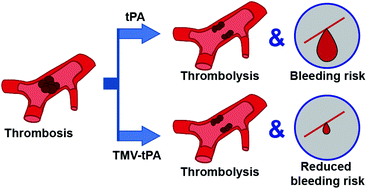Delivery of thrombolytic therapy using rod-shaped plant viral nanoparticles decreases the risk of hemorrhage†
Abstract
Cardiovascular thrombotic disease is an underlying cause of stroke, myocardial infarction and pulmonary embolism – some of the leading causes of death worldwide. Reperfusion therapy with anticoagulant, antiplatelet, and fibrinolytic agents has significantly reduced early mortality and morbidity from acute myocardial infarction and stroke. Nevertheless, bleeding side effects (e.g., intracranial hemorrhage) associated with the anti-thrombotic therapy can offset its benefits and limit its applicability to strictly defined short therapeutic windows. We have previously shown that elongated plant virus based nanoparticles can target cardiovascular thrombi and exhibited their utility for the delivery of streptokinase in an ex vivo model of thrombosis. Herein, we build upon our previous findings and demonstrate plant viral delivery of the current standard-of-care tissue plasminogen activator (tPA). Studies on a pre-clinical mouse model of arterial thrombosis indicate that while the therapeutic efficacy of free tPA and tPA-conjugated TMV are similar, the safety profile of the tPA-TMV formulation is improved, i.e. administration of the latter has less impact on hemostasis as demonstrated by decreased bleeding time. Thus, our data suggest that TMV-based delivery of thrombolytic therapies could be a promising and safer alternative to reperfusion therapy with the tPA.



 Please wait while we load your content...
Please wait while we load your content...